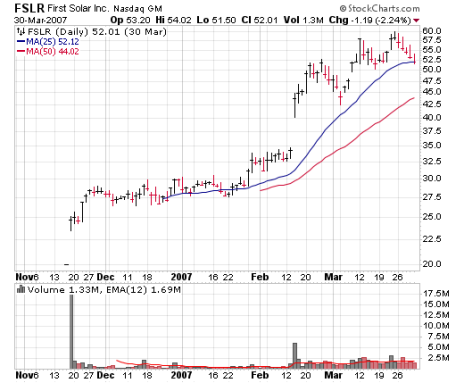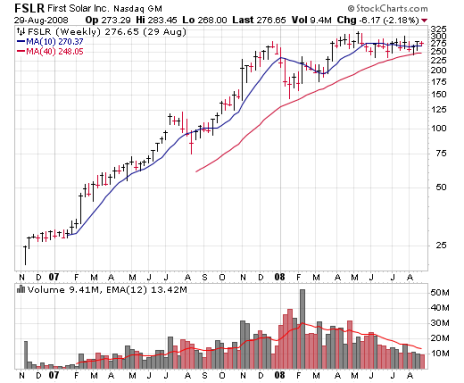My Stock Picking Criteria is Pretty Simple. But it’s Delivered Some Big Winners Over the Years.
Not too long ago on my Twitter account (you can follow me for free @MikeCintolo—I usually tweet out a couple of things I’m seeing in the market most days) I asked my followers for some content ideas—things that people wanted me to talk about in my weekly videos or my Cabot Wealth Daily columns that I might not be hitting on that readers/watchers wanted to hear about.
One idea (mentioned by a few people) involved stock picking criteria and how to hone in on stocks that I think can make big moves—not just 15% or 20%, but ones that can really double or triple over time. There’s nothing wrong with smaller gains, of course, but in my experience it’s the big outliers that really make a difference to your portfolio, while the smaller winners tend to be offset by the inevitable small losses.
I’ve written about many of these before, but now’s as good a time as any to lay them out in an organized way. In honor of my former partner-in-crime Paul Goodwin, I like to divvy the stock picking criteria up into three categories—Story, Numbers and Chart, which we call our SNaC approach.
[text_ad]
Stock Picking Criteria #1: Story
When it comes to evaluating a story, there are really two aspects to it.
The first, of course, is potential—we’re looking for stories that could lead to a company doubling or tripling in size, or more, in the years ahead. Ideally there should be no foreseeable limits on the growth potential if management pulls the right lever. This one is easy for most investors to grasp.
Second, and just as important, is likelihood of that growth being achieved. Here I’m looking at things like competition and any competitive advantages; customer concentration (if one customer stops ordering, will business go poof?) or regulatory risks; and just plain old judgment on how hard it will be to achieve the potential the company has.
Related to this is dependability, which is a crucial consideration for big investors. Think about it—if it took you a few weeks to build (and, eventually, get out of) a good-sized position in a stock, you want to be relatively sure the growth story has some staying power. Really, it’s the combination of big potential, high likelihood and dependability that incentivizes big growth fund managers with building positions—and that’s what can lead to great gains over time.
Stock Picking Criteria #2: Numbers
When it comes to growth numbers, I really try to keep it simple. I’m interested in the growth rates of sales and earnings over the past three or four quarters, the projections of sales/earnings for the upcoming year or so, and any key metrics that Wall Street is keying off of for that firm (sometimes EBITDA is more important than earnings, for instance, so I check on those growth rates).
I don’t have any absolute minimums or growth targets, but here are a few things I keep in mind:
- Both sales and earnings are vital, but if I had to choose one, it would be sales growth—Wall Street often pays up for sales growth if it thinks earnings are right around the corner.
- I generally want sales growth of at least 15% in recent quarters, and earnings of at least 20%—but preferably a lot more. My favorite thing numbers-wise is what I call Triple 30: 30% sales growth in the recent quarter or two, 30% earnings growth, 30% earnings estimates for the coming year or two.
- Accelerating growth in recent quarters is a plus; meanwhile, I’m not a fan of sharp deceleration (for example, 50%, 35% then 20% is a red flag that the growth phase is over).
Lastly, for trading volume, I like to see at least $50 million, and preferably $100 million, of daily dollar volume. (You get that by multiplying the stock price by its average volume over the past few weeks.) Below $50 million in volume can work, but those stocks tend to be choppy and not as many big investors traffic there.
Finally, valuation isn’t a concern for me, but I am aware of it—if a company is only growing 20% but has a P/E of, say, 45, I usually stay away. And if the valuation is truly crazy, I might look elsewhere. But an elevated valuation doesn’t bother me if the other pieces are in place.
Stock Picking Criteria #3: Chart
I obviously want stocks that act well—ones that are under accumulation. But I usually like to look for one of three general setups (which can actually overlap a bit).
The first is a base breakout, where a stock consolidates for many weeks or months (not just a week or two) and then powerfully leaps to new highs, possibly after a great earnings report. The base should be reasonable (not super choppy and volatile, which usually signifies distribution) and tighten up near the end. Honestly, though, I’m not a huge breakout player unless it’s really a perfect situation.
The second and more common pattern to rely on is what I call an early-stage pullback. Simply put, this is when a stock clearly moves out to new highs and still looks to be relatively early in its run (which is a whole other discussion), and then either tightens up or (preferably) pulls back for a few days toward some support, like its 25-day moving average. You can either buy on that pullback, or wait for a resumption of the uptrend (an early-stage pullback resumption).
Third, and one I’ve written about before, is volume clue support—when a stock (again, preferably early in its run) rises solidly on huge volume (either one or two giant days, or three or more great days of volume) and then begins to pull back in the days ahead. That “volume area” tends to lend support, as big investors haven’t been able to buy all they want over just a few days.
Putting it all together, let’s look at my first big winner I ever recommended after taking over Cabot Growth Investor at the start of 2007—First Solar (FSLR), which we bought in April 2007. Story-wise, solar demand was picking up steam in a huge way, especially overseas but also here. And First Solar wasn’t just another producer—its thin-film manufacturing process led to much lower costs, especially for utility-scale projects. With green energy just becoming popular, the potential was huge as costs declined and utilities diversified their power sources.
Numbers-wise, it could hardly get any better—First Solar sported triple-digit revenue growth and earnings were just moving into the black. And analysts were highly bullish on the future, with earnings expected to rise more than 100% in both 2007 and 2008 (and even those estimates proved wildly conservative).
Finally, looking at the chart, FSLR had just come public a few months before and showed an excellent earnings move in early February. Then, while the market suffered a short, sharp correction during the next few weeks, FSLR held up well and moved out to new highs—an early-stage pullback resumption in my book. We added it on March 22 at a price of 57 and you can see what happened in the second chart—it eventually marched above 300 before succumbing to the financial crisis.
Obviously, most trades won’t be like FSLR, but all you need is one big winner every now and then to make all the difference in the world, and you can increase your odds of finding them by using some of the stock picking criteria laid out above.
Or you can join Cabot Growth Investor where I recommend fast-growing stocks that have an opportunity to become the next First Solar. For details, click here.
[author_ad]
*This post has been updated from an original version.



